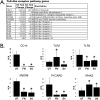Microarray analysis of human monocytes infected with Francisella tularensis identifies new targets of host response subversion
- PMID: 18698339
- PMCID: PMC2488368
- DOI: 10.1371/journal.pone.0002924
Microarray analysis of human monocytes infected with Francisella tularensis identifies new targets of host response subversion
Abstract
Francisella tularensis is a gram-negative facultative bacterium that causes the disease tularemia, even upon exposure to low numbers of bacteria. One critical characteristic of Francisella is its ability to dampen or subvert the host immune response. In order to help understand the mechanisms by which this occurs, we performed Affymetrix microarray analysis on transcripts from blood monocytes infected with the virulent Type A Schu S4 strain. Results showed that expression of several host response genes were reduced such as those associated with interferon signaling, Toll-like receptor signaling, autophagy and phagocytosis. When compared to microarrays from monocytes infected with the less virulent F. tularensis subsp. novicida, we found qualitative differences and also a general pattern of quantitatively reduced pro-inflammatory signaling pathway genes in the Schu S4 strain. Notably, the PI3K/Akt1 pathway appeared specifically down-regulated following Schu S4 infection and a concomitantly lower cytokine response was observed. This study identifies several new factors potentially important in host cell subversion by the virulent Type A F. tularensis that may serve as novel targets for drug discovery.
Conflict of interest statement
Figures





References
Publication types
MeSH terms
Substances
Grants and funding
LinkOut - more resources
Full Text Sources
Other Literature Sources
Molecular Biology Databases
Miscellaneous

